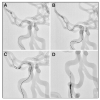Retrievable closed cell intracranial stent for foreign body and clot removal
- PMID: 18596519
- PMCID: PMC2675753
- DOI: 10.1227/01.neu.0000326023.16596.88
Retrievable closed cell intracranial stent for foreign body and clot removal
Abstract
Objective: To assess the technical feasibility of using a retrievable, closed cell intracranial stent delivered through a microcatheter for safe removal of foreign bodies or clot.
Methods: In vitro and in vivo testing were performed to demonstrate the feasibility of using retrievable intracranial stents for foreign body or clot removal. In vitro testing was performed in an anatomically correct silicone vascular replica by partially deploying the stent around a coil, then retracting the stent into the microcatheter to trap the coil. Withdrawal of the stent delivery system into the guide catheter resulted in coil removal. Subsequently, the technique was evaluated in a porcine model of intracranial aneurysms, wherein both fresh clot and herniated coils were extracted from the carotid arteries.
Results: In these experimental procedures, both herniated coils and fresh clot were safely and easily removed from the in vitro and in vivo models. No periprocedural adverse events were observed.
Conclusion: These in vitro and in vivo studies suggest the potential use of retrievable stents for the removal of foreign bodies or clot from the intracranial circulation.
Figures



Similar articles
-
Endovascular coil retrieval using a TrevoProVue stentriever.J Neurointerv Surg. 2015 May;7(5):e19. doi: 10.1136/neurintsurg-2014-011181.rep. Epub 2014 Apr 28. J Neurointerv Surg. 2015. PMID: 24778141
-
Endovascular coil retrieval using a TrevoProVue stentriever.BMJ Case Rep. 2014 Apr 23;2014:bcr2014011181. doi: 10.1136/bcr-2014-011181. BMJ Case Rep. 2014. PMID: 24759162 Free PMC article.
-
A novel self-expanding fully retrievable intracranial stent (SOLO): experience in nine procedures of stent-assisted aneurysm coil occlusion.Neuroradiology. 2006 Jul;48(7):471-8. doi: 10.1007/s00234-006-0062-7. Epub 2006 Jun 7. Neuroradiology. 2006. PMID: 16758153 Clinical Trial.
-
Retrieval of iatrogenic intravascular foreign bodies.J Vasc Surg. 2013 Jan;57(1):276-81. doi: 10.1016/j.jvs.2012.09.002. Epub 2012 Nov 7. J Vasc Surg. 2013. PMID: 23140798 Review.
-
Update on laser lead extraction.J Invasive Cardiol. 2009 May;21(5):230-2. J Invasive Cardiol. 2009. PMID: 19411725 Review. No abstract available.
Cited by
-
ADVANCE: An effective and feasible technique in acute stroke treatment.Interv Neuroradiol. 2017 Apr;23(2):166-172. doi: 10.1177/1591019916682358. Epub 2016 Dec 13. Interv Neuroradiol. 2017. PMID: 28304200 Free PMC article. Clinical Trial.
-
Effectiveness of mechanical endovascular thrombectomy in a model system of cerebrovascular occlusion.AJNR Am J Neuroradiol. 2012 Nov;33(10):1998-2003. doi: 10.3174/ajnr.A3103. Epub 2012 May 3. AJNR Am J Neuroradiol. 2012. PMID: 22555570 Free PMC article.
-
Stent retriever use for retrieval of displaced microcoils: a consecutive case series.AJNR Am J Neuroradiol. 2013 Oct;34(10):1996-9. doi: 10.3174/ajnr.A3552. Epub 2013 Jun 13. AJNR Am J Neuroradiol. 2013. PMID: 23764724 Free PMC article.
-
Stenting in the treatment of acute ischemic stroke: literature review.Front Neurol. 2011 Dec 9;2:76. doi: 10.3389/fneur.2011.00076. eCollection 2011. Front Neurol. 2011. PMID: 22163225 Free PMC article.
-
Biomechanics and hemodynamics of stent-retrievers.J Cereb Blood Flow Metab. 2020 Dec;40(12):2350-2365. doi: 10.1177/0271678X20916002. Epub 2020 May 19. J Cereb Blood Flow Metab. 2020. PMID: 32428424 Free PMC article. Review.
References
-
- Asakura F, Yilmaz H, Abdo G, Sekoranja L, Millan D San, Augsburger L, Sztajzel R, Ruefenacht DA, Perren F, Lovblad KO, Goto K. Preclinical testing of a new clot-retrieving wire device using polyvinyl alcohol hydrogel vascular models. Neuroradiology. 2007;49:243–251. - PubMed
-
- Fessler RD, Ringer AJ, Qureshi AI, Guterman LR, Hopkins LN. Intracranial stent placement to trap an extruded coil during endovascular aneurysm treatment: Technical note. Neurosurgery. 2000;46:248–251. - PubMed
-
- German WJ, Black SP. Experimental production of carotid aneurysms. N Engl J Med. 1954;250:104–106. - PubMed
-
- Levy EI, Ecker RD, Horowitz MB, Gupta R, Hanel RA, Sauvageau E, Jovin TG, Guterman LR, Hopkins LN. Stent-assisted intracranial recanalization for acute stroke: Early results. Neurosurgery. 2006;58:458–463. - PubMed
Publication types
MeSH terms
Grants and funding
LinkOut - more resources
Full Text Sources
Other Literature Sources
Medical

